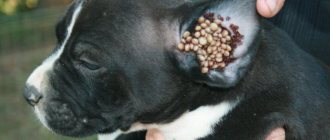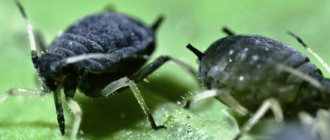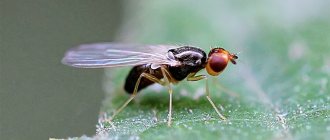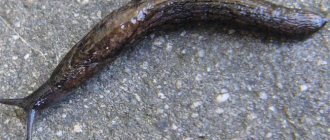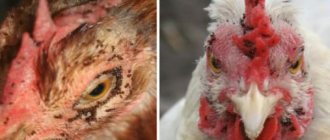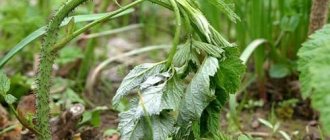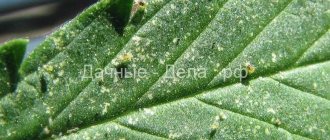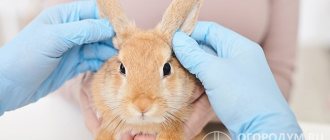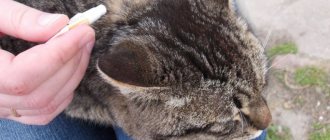As you know, rabbits are popularly called eared rabbits. They received this name due to their specific long ears, which distinguish the animals from other representatives of the fauna.
But rabbits need ears not only to hear, but also to analyze their environment and carry out thermoregulation. This part of the body is almost not protected by fur, so it becomes very vulnerable to external aggressive factors. Microscopic mites that live in the ears cause serious harm to rabbits.
These parasites cause the ear disease psoroptosis (otodectosis), known among rabbit breeders, which is popularly called ear scabies.
Cause of mites in rabbits
Where do ear mites come from in domestic rabbits?
Most often, animals suffer from this disease in the autumn-winter period. The cause of infection is infection through contact of a healthy individual with an infected one. It's not just another rabbit that can carry ear mites. You can become infected:
- through the owner's work clothes;
- through care items for other pets;
- through a cage in which sick rabbits were kept;
- through an infected rabbit who gave birth to rabbits;
- through other infected pets: cats and dogs.
The conditions in which rabbits are kept can also cause the rapid spread of psoroptosis. These factors include:
- rare cleaning of the cage;
- high humidity in the room with animals;
- cramped conditions in the cage;
- unbalanced diet and lack of vitamins;
- frequent regrouping of pets.
If an ear mite finds itself in a favorable environment, it develops quite quickly.
Features of the disease
The causative agent of psoroptosis is an oval mite (0.2-0.8 mm in size) with a yellow color. It spreads quite quickly, especially if hygiene is not observed in places where animals are kept through carriers (mice, rats) and between individuals in contact with each other, so it is very important to identify the disease in time. Any breed of rabbit can suffer from psoroptosis.
Tick infestation quickly spreads among animals, regardless of their breed and age
Even minor signs of illness cannot be ignored. Animals attacked by parasites lose their appetite and lose weight, and changes in biological and physical processes begin to occur in their bodies. Males often lose the ability to mate, and females stop feeding their young.
Diagnosis of psoraptosis
The symptoms listed above are quite enough to identify the disease and begin treatment immediately. But to be completely sure, you can examine the sick rabbit and study tissue fragments.
The size of an adult female ear mite significantly exceeds the size of male individuals and reaches almost 1 mm. Such impressive dimensions allow you to track the presence of parasites directly in their habitats, if you are armed with a magnifying glass. Scab scraping, mixed with heated Vaseline and smeared on glass, will also allow you to visually identify the culprits of the disease. Those who doubt the result can contact a veterinary laboratory.
Tetracycline
Antibiotic agent with a wide spectrum of action. Affects gram-positive and gram-negative bacteria; on some protozoa.
Contraindications:
- hypersensitivity;
- kidney disease;
- liver diseases.
Possible side effects:
- allergic reactions;
- diarrhea;
- nausea, vomiting.
Give up to 100 mg to young animals, up to 250 mg of the drug to adults.
How to treat
After ear mite bites have been detected or the first warning symptoms have been identified, you should immediately contact a veterinarian in order to extinguish the source of the disease in time and protect other individuals from contracting the infection.
This can be done with Vaseline or hydrogen peroxide. It is enough to carefully soften the crusts that have formed on the ear with these products, which will protect the rabbit from unpleasant sensations. After this, you should remove the crusts, after wearing gloves.
Note that these crusts, or scabs, contain a lot of mites, so the procedure must be carried out very carefully. The scabs must be placed in a special container and then burned or doused with chlorine.
Ointments
Homemade ointments are considered effective for the treatment of ear disease. To make the medicine, you will need the following ingredients:
- vegetable oil;
- turpentine;
- camphor oil.
Having mixed all the ingredients, the ointment is placed in a syringe, from which the needle has been previously removed, and applied to the ears. This procedure should be repeated several times.
Drops
As an alternative to traditional methods of treating the disease, there are pharmaceuticals and medications that will help remove ear mites. These are different drops that are intended for dogs and cats. They are also suitable for rabbits and allow them to get the desired result. Let's list some of them:
- Amitrazine;
- Invermectin;
- Selamectin.
Any drug has detailed instructions, which indicate how to use it correctly and in what doses to give to the rabbit.
Sprays and aerosols
To cure your pet, you can use spray or aerosols, and the treatment will not take much time. As a rule, the effect of an ointment, aerosol or drops comes after the first use. Aerosols that will relieve a rabbit from the disease are:
- Dermatosol;
- Cyodrine;
- Psoroptol.
The annotation for each of these remedies contains instructions that will allow you to correctly use the medicine to treat the ear canal.
To combat parasites and ticks in rabbits and other animals, the drug “Butox-50” is used. Each package contains 5 ampoules.
- To start treatment, you need to take one ampoule and dilute it using 1 liter of warm water.
- After this, the resulting solution is poured into a spray bottle.
- The ears should be sprayed 2-3 times.
Since the effect of the drug is on adult ticks, and not on their eggs, the procedure must be repeated after 5 days. This method of treatment is convenient and simple. However, the solution should not be cold, but should correspond to the rabbit’s body temperature.
Such methods of treating the disease will not allow otitis media to develop and lead to complications. The rabbit's ear is a hypersensitive organ that needs constant and careful examination.
Stronghold
The drug Stronghold 12% 0.25 ml (purple cap) is used for parasitic diseases of rabbits. The active ingredient is selamectin. Apply to the withers. Safe at any age. Kills insects and stops egg incubation.
The dosage is calculated depending on the patient's weight. Contraindication: hypersensitivity to the components of the drug.
Mycoses (microscopic fungi) complicating ear scabies
Sometimes ear mites are confused with similar diseases that accompany scabies in the ears of rabbits, which are accompanied by discharge from the ears. Psoroptosis - scabies of rabbit ears, when prolonged, is complicated by the pathogenesis of fungal and/or bacterial otitis. Ear discharge due to mycoses and bacterial infections accompanying scabies complements the clinical manifestations with a fundamentally different type of ear discharge (plaque on the ears). Almost always, yeast fungi are combined with ear mites, since fungi do not live on healthy skin.
Photo. You probably think that mycoses in rabbit ears are a type of ringworm.
For some reason, mycodermatoses are usually associated with ringworm. This is wrong. Clinically significant mycoses on ears damaged by mites can even be caused by conditionally pathogenic soil fungi. The danger of fungi is that under normal conditions they are common inhabitants of damp areas of soil or saprophytes of the skin of animals and humans and are not clinically noticeable.
When they come into contact with mite-damaged auricles, they instantly form colonies in the form of scabs on the inner surface of the auricles. See the photo above for one example. According to foreign sources, microscopic fungi belonging to different genera were detected in rabbit ears:
- Candida (all types) - plaque on the integument of the ears, such as thrush;
- Malassezia pachydermatis - itching, red, flaky skin, oily dandruff, unpleasant odor;
- Microsporum gypseum - small crusts resembling a coating of plaster, the ear covers are swollen, red (hyperemia);
- Rhodotorula rubra - various colonies;
- Scopulariopsis brevicaulis - rough coating resembles the shape of warts;
- Trichophyton mentagrophytes - rough coverings resembling tiles;
- Trichophyton terrestre - rough layers.
Fungi complicate the pathogenesis of ear scabies in rabbits weakened by disease with depression of the immune system.
The final diagnosis is laboratory tests. To treat ear mycoses, griseofulvin tablets, Exoderil cream, and clotrimazole ointment are used. All medications are medical. There are practically no tablet medications for the treatment of yeast-like mycoses in animals. Vaccines against trichophytosis and microsporia of rabbits are not effective in this case. Ear scabies are treated after clearing the ears of colonies of yeast-like fungi. Only after this do they begin re-checking for ear psoroptosis, and only after mites are detected in a microscope do they begin to treat ear mites.
Drug treatment
The first stage of treatment for parasites is to rid the animal of hardened crusts and scabs that have formed on the inner surface of the ears.
For this you will need:
- gloves;
- cotton swabs;
- hydrogen peroxide.
To begin with, the rabbit must be well secured so that it cannot resist the procedure. Remember that these animals have quite strong hind legs - with them they can cause injury to a person. Then you need to take a cotton swab, soak it generously in hydrogen peroxide and treat the affected areas of the ears. When the crusts become softer, they can be carefully removed. Removed scabs must be disposed of using bleach or incineration.
Regularly cleaning your ears from dry crusts will increase the effectiveness of using medicationsThe second stage of ridding an animal of ear mites is to use special medications or various folk remedies. Recommendations for the use of some medications are given in the table:
| Name | Release form | Features of application |
| Dekta | Drops | Before using the drug, the external auditory canal must be thoroughly cleaned of surface crusts and scabs using a cotton-gauze swab soaked in camphor alcohol or hydrogen peroxide. The medicine is instilled into the animal’s ears, 3-5 drops. Treatment is carried out 2-3 times with an interval of 3-5 days. If necessary, the course of treatment is repeated until complete recovery. |
| Butox-50 | Ampoules | The contents of 1 ampoule are diluted in 1 liter of warm water. The resulting solution is applied to the inside of the rabbits' ears by irrigation from a spray bottle. The treatment is repeated 3-4 times at intervals of 5-6 days. |
| Acaromectin | Spray | The drug is sprayed onto the inner surface of the ear (previously cleaned of scabs), holding the bottle at a distance of 10-12 cm, 2-3 times a day. Repeated treatment is carried out after 7 days |
| Ivermectin | Ampoules | The drug is used for subcutaneous injections in the treatment of psoroptosis in the later stages in combination with external treatments |
Treatment should begin when the first signs of the disease appear
Hartz
The active ingredients are tetrachlorvinphos and methoprene. Protects the animal from fleas for 5 months. Destroys parasites, their eggs, larvae, adults. There is a reflective strip. Available in several modifications and colors.
Any collar is only suitable for an adult. Rabbits can easily reach it with their teeth and chew it off. This leads to the animal being poisoned.
Preparations in the form of tablets allow you to get rid of the dangerous consequences of flea infestation in rabbits. They are used in case of deterioration in the general condition of the animal. Symptoms indicate serious diseases in rabbits:
- the presence of blood in the stool;
- change in color of the mucous membrane of the mouth and eyes;
- drowsiness;
- loss of appetite;
- temperature rise up to +40°C;
- nervousness, etc.
Drugs in tablet form are available in pharmacies only with a prescription.
Treatment of ear mites in rabbits with folk remedies at home
Not all substances in this group can be used to treat the affected ear. The choice of product depends on the condition of the outer skin and the degree of skin damage.
Kerosene and any vegetable oil
This method helps not only to destroy the tick, but also to clean the outer coverings of crusts. To prepare it, take kerosene and vegetable oil in a 1:1 ratio. A folk remedy is to treat the skin using a cotton swab. You can lightly rub the substance.
Kerosene acts on ticks at all stages of their development
Vegetable oil and turpentine
The principle of operation of the product does not differ from the mechanism of operation of a mixture of kerosene and oil. Only in this case it is necessary to use turpentine in a dosage that is 2 times less than the volume of vegetable oil. Treatment is continued until complete recovery.
Do not use near open flames
Camphor oil
It is enough to carry out the treatment procedure once daily. This remedy helps relieve psoroptosis. Camphor oil helps soften hard crusts. In addition, during treatment, such a product does not allow parasites to breathe.
Helps relieve pain
Glycerin and iodine solution
Mix the components in a ratio of 4:1. In order not to cause a burn to the outer skin, you should make sure that there is less iodine than glycerin. This is an antibacterial agent.
One of the effective remedies is glycerin with iodine.
Sulfur
I use colloidal sulfur. Moreover, it is recommended to use a product whose concentration is 2%. Treatment regimen: treatment is carried out 2 times with a break of at least 10 days.
Oxygen sulfur
Bee Honey
Prepare a solution: 100 ml water, 3 tsp. honey It is used to clean the ears. This remedy is not used to get rid of ticks, but helps improve the condition of the outer skin and accelerates the healing of wounds.
Natural honey helps improve the condition of woundsWhite vinegar
The substance is mixed with water in a ratio of 1:2. This product accelerates the cleansing of external sinks from dirt and traces of parasites. In addition, vinegar helps create unacceptable living conditions for ticks. However, treatment with such a solution is not always suitable for rabbits.
The wound can be treated with water and vinegar
Apple cider vinegar and olive oil mixture
Prepare a working solution: take vinegar and oil in a ratio of 1:2. It is used to bury ears. A single dose is no more than 7 drops.
Apple vinegar
Bayer ADVANTAGE 80
The active ingredient is a 10% solution of imidacloprid. A one-time treatment will protect against secondary infection for 30 days. The effects of the bites will stop within 5 minutes after the procedure. Destroys larvae. Prevents diseases such as:
- bartonellosis; - dipylidiasis; — calcivirosis; - rickettsial diseases.
Safe for young rabbits, pregnant females, and lactation rabbits.
Contraindications:
- age up to 10 weeks; - hypersensitivity to the components of the drug.
It is not allowed to be used on rabbits that are bred for subsequent consumption; it is only suitable for domestic decorative rabbits.
Symptoms
As a result of the spread of mites, the animal experiences itching and severe irritation. With early detection and timely treatment, the disease is not dangerous. If the disease is advanced, a secondary bacterial infection may occur.
The spread of mites to the middle and inner ear can lead to otitis media, damage to the central nervous system, and a brain tumor. In this case, the rabbit constantly tilts its head and often loses its balance. The infected female refuses her rabbits and mates with the male. If the disease is neglected, the mites will spread to the rabbit's entire body. As a result, the rodent may develop itching, the skin becomes red, hair falls out, ulcers and dermatitis form. If treatment is not timely, the death of the animal is inevitable.
It is important to know the symptoms and regularly examine your pets for early detection of ticks and timely treatment for parasites.
What is the danger of fleas and their eggs for rabbits?
Rabbits are sensitive animals to stress and illness. Flea infestation leads to the following pathologies:
- Myxomatosis. This is a serious viral disease accompanied by purulent conjunctivitis. A sick rabbit develops tumors in the head, anus and genital areas. Domestic and ornamental animals are sensitive to the pathogen carried by rabbit fleas. Parasites inject the virus into the rabbit's blood when they bite. As a preventive measure, pets are vaccinated, since treating myxomatosis is ineffective.
- Helminthiasis. Fleas are temporary hosts of some types of helminths. If a rabbit bites an insect, the parasite larva will enter the body, causing helminthic infestation.
- Anemia. Develops in advanced cases due to large blood loss.
From constant bites, the animal experiences severe itching, causing scratching and skin irritation. The animal loses appetite, sleep, becomes irritated and nervous.
Diagnostics
To accurately determine the presence of a parasite in a rabbit’s body, you need to scrape the inside of the ear and conduct tests.
This can be done through a laboratory test, in which the collected secretions are examined by a doctor under a microscope.
Determining the parasite using a microscope There is another method that you can do at home yourself. For diagnosis you will need:
- petrolatum;
- sharp instrument;
- a piece of glass;
- magnifying glass.
Did you know? Ticks that enter the environment with pieces of epithelium or crusts can survive in suitable conditions without an animal for approximately 21 days.
Vaseline is heated to a temperature of +40 °C. What was separated from the problem area in the ear is placed in it for a short period of time. Then the substance is leveled on glass and examined under a magnifying device. The presence of mites will be indicated by movement in the substance.
Prevention measures
It is much easier to prevent any disease than to treat it later. Therefore, it is necessary to inspect and clean the ears of pets as often as possible. It is recommended to do this twice a month. With all this, pregnant females will need to be treated two weeks before the birth of offspring, including during the absence of signs of ear mites. And during contact with infected animals, you must wash your hands thoroughly so as not to accidentally infect healthy animals.
For prevention, it is recommended to carry out the necessary disinfection of working instruments, power supply devices and the cells themselves twice a year. Acquired young animals must be kept in quarantine for several weeks, in the absence of contact with the main livestock, in order to prevent the appearance of such a dangerous parasite as the scabies mite.
Preventive actions:
Eating unspoiled and clean food. Proper feeding is the key to good immunity. Make it a habit to inspect your rabbit population frequently. Pregnant females must be examined two weeks before they give birth. Keep in dry and cleaned cages. There cannot be dampness or drafts in the rooms where rabbits are located. If animals are kept in cages in the fresh air, then care must be taken to protect them from rain with awnings, and from the wind with awnings, film with a frame, and shields. It is advisable to clean the cages twice a day. An important measure is the disinfection of instruments, cages and premises twice a year: in autumn and spring. And if symptoms of the disease are detected, then disinfection is carried out immediately. Hot mixtures of quicklime (for whitewashing premises), soda ash (preferably caustic) are used. Quicklime can be used to make a composition for treating cells and instruments. Lime must be diluted with water in a 1:1 ratio. After the quenching process, add another 10 parts of water. The composition is applied immediately
Precautions must be taken. During slaking, lime releases a large amount of heat
Chlorine is also considered an excellent remedy. If ear mites are found in rabbits, immediately isolate the infected animals away from the rest of the herd. Infected rabbits must be treated immediately and kept in a quarantine cage for at least 20 days. If no diseases are detected during this period, then the animals can be transplanted into the main herd. To avoid serious complications that could lead to the death of the animal, it is necessary to promptly respond to the rabbit’s unusual behavior and its external changes. Wash your hands often and examine your pets. Animal boarding standards must be observed. Crowded content can lead to clashes. Rabbits cause serious damage to each other. The weakest are pushed away from drinking bowls and feeders. Separate females from males in a timely manner. Identify aggressive animals and keep them separated. During mating of animals, there is no need to take rabbits from other farms. If such a need arises, then carefully examine the animal that comes to you for psoroptosis in the ears. If there is any suspicion, the rabbit must be immediately returned to the owner. Other domestic animals such as cats and dogs can also be carriers of the disease. Well, the owner can directly bring the infection by petting a sick animal.
Attentive breeders know the habits and habits of their pets, and if something starts to go wrong, they promptly begin to sound the alarm for signs of illness.
The most important thing is to prevent the inflammatory process from spreading inside the body, so it will be much easier to deal with the mite than with the brain tumor it causes. She will need to be treated for a very long time, and no one can guarantee that the treatment will be successful.
Drontal®
The active substance is pyrantel. Available in the form of tablets (24 pieces per package). The dosage is calculated depending on the weight of the animal: 1 tablet per 4 kg. Broad-spectrum anthelmintic agent. It is recommended to use for preventive purposes at least 4 times a year.
Contraindications:
- animal weight up to 1 kg;
- the animal is weakened by disease.
Use only on the recommendation of a veterinarian.
Special shampoos, combs, ointments, sprays, and powders will help destroy fleas on a rabbit. Shampoos are suitable for kittens. If you have problems with bathing (this procedure causes stress for some pets), use other means.
List of simple remedies for ear mites in rabbits
Despite the fact that some rabbit breeders do not consider ear scabies to be a serious disease, it can cause the death of a large number of animals. The main reason is complications that arise due to the lack of timely taken therapeutic and preventive measures. Therefore, treatment should begin immediately after identifying an ear mite.
The treatment presented below is for informational purposes only! Only a doctor can prescribe the correct treatment regimen for rabbits!
To treat ear scabies, systemic medications or local treatments for the affected ears are used.
| Systemic therapy | Local treatment |
| • Injections of macrocyclic lactones (avermectins) for administration under the skin or intramuscularly. • Ivermek, Ivomek, Baymek. • Antibiotics (prescribed for complications). | • Synthetic pyrethroids (powders, ointments, drops, creams, sprays, emulsions). Apply twice, with an interval of 7-10 days (according to the instructions). • Cypermethrin, neostomazan, entomozan, butox, psoroptol, dermatosol, acaromectin. |
First, the rabbits are prepared for treatment, and then the medication is applied. It is worth remembering that ear treatment is carried out only with sterile rubber gloves.
- Preparatory phase. Before treatment, the animal’s ears should be cleaned of scales, dirt, and wax. The eared ear is fixed well, moistened with a cotton swab, and the ear scabs are softened. Mineral or vegetable oils, hydrogen peroxide, glycerin, iodine-glycerin mash (1:4) are good for softening crusts in the ears. If the damage is minor, after cleaning and treating the ears, the parasites may disappear and the rabbit may recover.
- The main treatment phase. After the initial cleaning, the ears can already be treated with acaricidal agents.
Emulsions against ear mites
Frequent use of emulsions means that they begin to act almost from the moment of application. Apply using cotton swabs, after application the ears are massaged well.
Among the most popular liquid forms:
- Dekta;
- Butox;
- Valekson;
- Neocidol;
- Cyodrine;
- Selamectin;
- Unoiled;
- Entomozan.
Treatment with sprays
The most versatile and easy to use is an aerosol method of treating psoroptosis. The spray is sprayed onto the affected ear for up to 5 seconds from a distance of 10-15 cm.
Popular means are:
- Cyodrine;
- Dicrazil;
- Psoroptol;
- Dermatosol;
- Akrodex.
Spray Frontline
Bottle dosage: 1-2 pumps per 1 kg of weight. Spraying should be carried out from a distance of 40 cm from the animal. Apply only from the back to prevent the animal from licking drops of the drug. Before use, it is recommended to ruffle the animal’s fur to speed up the penetration of the drug onto the skin. The active substance, absorbed into the skin, spreads throughout the body and begins to accumulate in the sebaceous ducts. Protection is provided for 4 months.
Important! Cases of poisoning of domestic rabbits by Frontline have been reported. Consult your veterinarian before using the spray.

